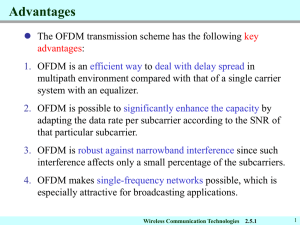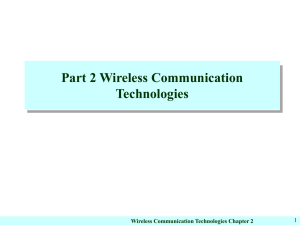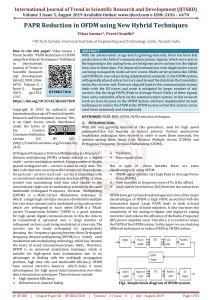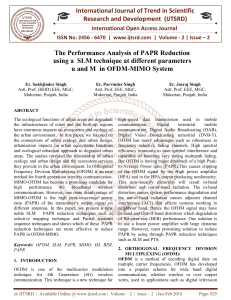IRJET- Overview of PAPR Reduction Techniques of OFDM System
advertisement
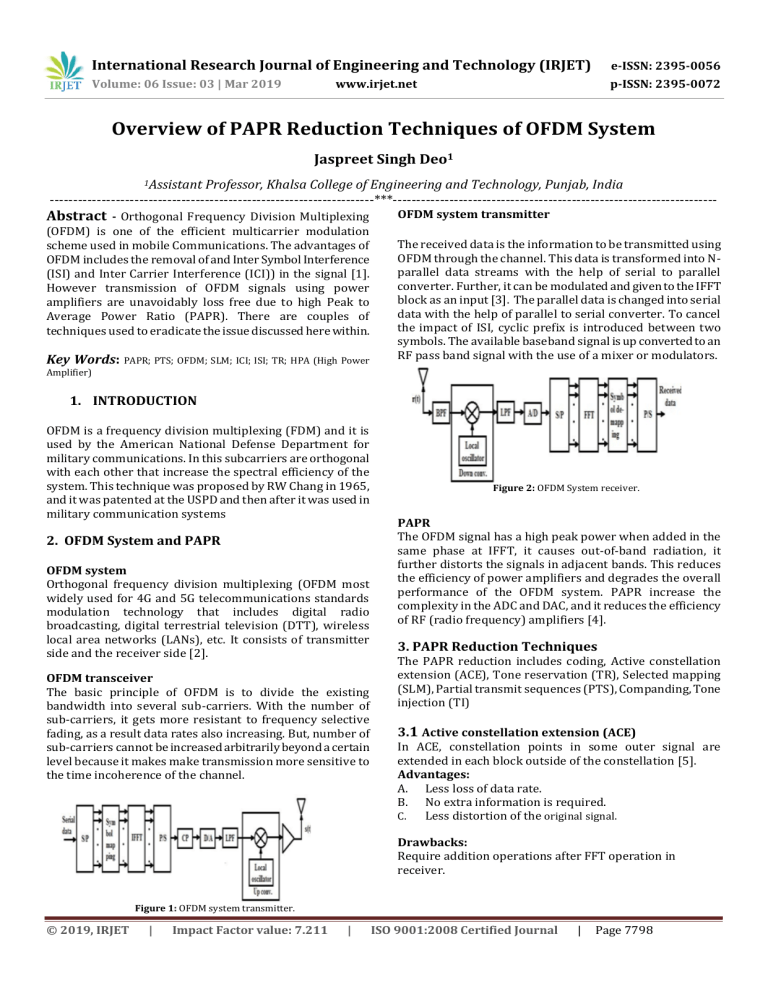
International Research Journal of Engineering and Technology (IRJET) e-ISSN: 2395-0056 Volume: 06 Issue: 03 | Mar 2019 p-ISSN: 2395-0072 www.irjet.net Overview of PAPR Reduction Techniques of OFDM System Jaspreet Singh Deo1 1Assistant Professor, Khalsa College of Engineering and Technology, Punjab, India ---------------------------------------------------------------------***--------------------------------------------------------------------- Abstract - Orthogonal Frequency Division Multiplexing (OFDM) is one of the efficient multicarrier modulation scheme used in mobile Communications. The advantages of OFDM includes the removal of and Inter Symbol Interference (ISI) and Inter Carrier Interference (ICI)) in the signal [1]. However transmission of OFDM signals using power amplifiers are unavoidably loss free due to high Peak to Average Power Ratio (PAPR). There are couples of techniques used to eradicate the issue discussed here within. Key Words: PAPR; PTS; OFDM; SLM; ICI; ISI; TR; HPA (High Power OFDM system transmitter The received data is the information to be transmitted using OFDM through the channel. This data is transformed into Nparallel data streams with the help of serial to parallel converter. Further, it can be modulated and given to the IFFT block as an input [3]. The parallel data is changed into serial data with the help of parallel to serial converter. To cancel the impact of ISI, cyclic prefix is introduced between two symbols. The available baseband signal is up converted to an RF pass band signal with the use of a mixer or modulators. Amplifier) 1. INTRODUCTION OFDM is a frequency division multiplexing (FDM) and it is used by the American National Defense Department for military communications. In this subcarriers are orthogonal with each other that increase the spectral efficiency of the system. This technique was proposed by RW Chang in 1965, and it was patented at the USPD and then after it was used in military communication systems 2. OFDM System and PAPR OFDM system Orthogonal frequency division multiplexing (OFDM most widely used for 4G and 5G telecommunications standards modulation technology that includes digital radio broadcasting, digital terrestrial television (DTT), wireless local area networks (LANs), etc. It consists of transmitter side and the receiver side [2]. OFDM transceiver The basic principle of OFDM is to divide the existing bandwidth into several sub-carriers. With the number of sub-carriers, it gets more resistant to frequency selective fading, as a result data rates also increasing. But, number of sub-carriers cannot be increased arbitrarily beyond a certain level because it makes make transmission more sensitive to the time incoherence of the channel. Figure 2: OFDM System receiver. PAPR The OFDM signal has a high peak power when added in the same phase at IFFT, it causes out-of-band radiation, it further distorts the signals in adjacent bands. This reduces the efficiency of power amplifiers and degrades the overall performance of the OFDM system. PAPR increase the complexity in the ADC and DAC, and it reduces the efficiency of RF (radio frequency) amplifiers [4]. 3. PAPR Reduction Techniques The PAPR reduction includes coding, Active constellation extension (ACE), Tone reservation (TR), Selected mapping (SLM), Partial transmit sequences (PTS), Companding, Tone injection (TI) 3.1 Active constellation extension (ACE) In ACE, constellation points in some outer signal are extended in each block outside of the constellation [5]. Advantages: A. Less loss of data rate. B. No extra information is required. C. Less distortion of the original signal. Drawbacks: Require addition operations after FFT operation in receiver. Figure 1: OFDM system transmitter. © 2019, IRJET | Impact Factor value: 7.211 | ISO 9001:2008 Certified Journal | Page 7798 International Research Journal of Engineering and Technology (IRJET) e-ISSN: 2395-0056 Volume: 06 Issue: 03 | Mar 2019 p-ISSN: 2395-0072 www.irjet.net 3.2 Tone reservation (TR) 4. CONCLUSIONS It reserves few tones and assign them suitable values [6]. Advantages: A. No distortion is introduced to the data bearing tones B. No side information is required. In this paper, it is compared and analyses different PAPR reduction techniques. However, no technique solely eradicate PAPR problem. Before implementing the technique various other factors like maintaining data rate, computational complexity, BER, signal power should also be taken into acknowledgement. REFERENCES Drawbacks: A. Improves the average energy per bit. B. Loss of spectral efficiency. C. 1. Litwin, Louis, Pugel, Michael (2001) The principles of OFDM. RF Signal Processing, pp. 30-48. 3.3 Selected mapping (SLM) In this, some candidate data blocks are created and the one with lowest PAPR is transmitted. [7]. Advantage: A. No distortion is introduced. B. Independent of number of carriers. 2. Yao Y, Ma S, Hu J (2013) A PAPR reduction scheme with residue number system for OFDM. EURASIP Journal on Wireless Communications and Networking, pp. 1-11. 3. Bingiham J (1990) Multicarrier modulation for data transmission: an idea whose time has come. IEEE Commun Mag 28(5): 5-14. 4. Han SH, Lee JH (2005) An overview of peak-to-average power ratio reduction techniques for multicarrier transmission. IEEE Wirel Commun 12(2): 56-65. Drawback: A. Extra information is required. B. Corrupt BER performance. 5. Lee BM, Kim Y (2013) An adaptive clipping and filtering technique for PAPR reduction of OFDM signals. Circuits, Systems and Signal Processing 32(3): 1335-1349. 3.4 Partial transmit sequences (PTS) The subcarriers in each of the sub blocks are rotated by phase factor, so the PAPR of the combination is minimized [8]. 6. Wang YC, Luo ZQ (2011) Optimized Iterative Clipping and Filtering for PAPR Reduction of OFDM Signals. IEEE Trans Commun 59(1): 33-37. 7. Jeon HB, Shin DJ (2011) A low complexity SLM scheme using additive mapping sequences for PAPR reduction of OFDM signals. IEEE Trans Broadcast 57(4): 866-874. Advantage: A. Less distortion is introduced. B. Less complex. 8. Chen Ye (2014) PAPR reduction of OQAM-OFDM signals using segmental PTS scheme with low complexity. IEEE Trans Broadcast 60(1): 141-147. Drawbacks: A. Side information is required 3.5 Companding In this technique, the small signals are enlarged while compressing the large signals. The compression is done out at the transmitter end. The Compression of the signal decreases the high peaks, as a result PAPR is reduced [9]. 9. Li CP, Wang SH (2010) Novel low complexity SLM schemes for PAPR reduction in OFDM systems. IEEE Trans Signal processing 58(5): 29162921. Advantage: Less distortion is introduced. Drawback: Loss of data rate. Tone injection (TI) The TI technique, basic idea is to increase the constellation size so each point present in the original constellation could be mapped into various equivalent points. In an original constellation point, the equivalent constellation points are added so PAPR reduced. The calculation of the sub-carrier time domain signals also gives lowered PAPR [9]. Advantage: No data rate loss. Drawback: Require modulo-D addition, after an FFT operation in the receiver. © 2019, IRJET | Impact Factor value: 7.211 | ISO 9001:2008 Certified Journal | Page 7799



